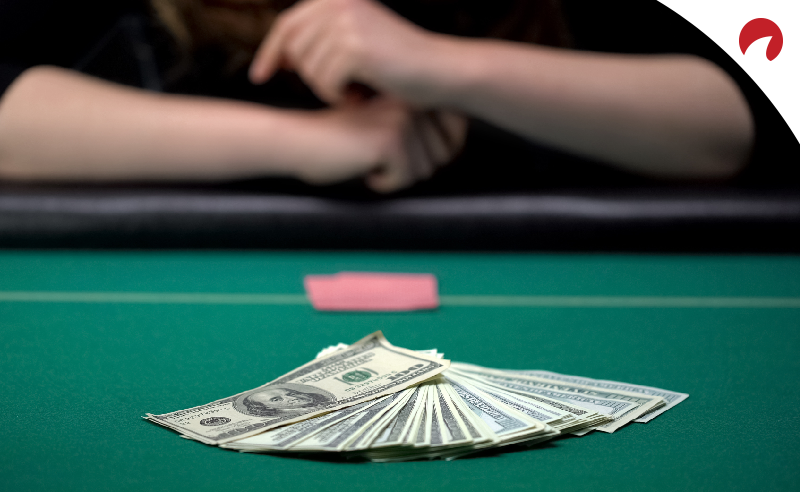Did you know it’s relatively easy to play poker without ever going broke?
It’s done through a skill called bankroll management and it allows professional players to survive the sometimes vicious volatility of No-Limit Hold’em.
The goal of good bankroll management is to limit potentially back-breaking losses at the poker table. The general idea is to never risk too much money on a single game of poker.
For instance you should NEVER risk your entire bankroll in a single game. Even the best players in the world get unlucky sometimes and if you lose your entire bankroll it might keep you from ever playing poker again. Instead there are plenty of solid tactics to keep a healthy bankroll that will be able to withstand numerous downswings and keep you in the game until things start going your way.
It should be said that players have very different approaches to bankroll management. Some like to gamble and play big games when the opportunity presents itself while others like to be more cautious. We’ll take a look at both strategies below, but first we'll start with what poker bankroll management actually is.
What is Poker Bankroll Management?
Poker takes skill to master, but, ultimately, it’s a game of luck. Even elite players can go broke sometimes. That’s why proper bankroll management should be a crucial activity.
But what is poker bankroll management, exactly? And how do you do this effectively in the middle of an exciting, high-stakes game?
First, poker bankroll management is just a system for effectively managing your poker money so you don’t find yourself in financial trouble.
Second, managing it effectively takes a plan, and the discipline to stick to that plan. Developing good bankroll habits early will help you in the long-run and we’re here to show you how.
There are three basic rules to follow:
- Only play with funds you can afford to lose
- Play games that have stakes within your skill level
- Be patient
Building a solid poker bankroll takes time, but if you’re patient, the rewards will be plenty and you’ll have a lot more fun. Trust us.

How to Build your Bankroll
What’s the best way to build a bankroll?
Well the simplest way is to just buy one. It’s not complicated. $50 is more than enough to get you started playing online poker. For live poker you’ll probably want to have more like $2,000 because the minimum stakes are much higher.
If you’re looking to avoid spending any money on poker then you could attempt to score some freerolls on an online poker site.
Freerolls are free tournaments that online poker sites usually give to new players. Generally, you have to sign-up and make a minimum deposit but most online poker sites will give you at least a couple freeroll tickets where you’ll have a shot at winning some free money.
Another good way to build a bankroll is the sign-up bonus. Poker sites love getting new players so they often offer a sign-up bonus where they’ll match your deposit. The match is usually set at 100% so if you deposit $100 you have a chance at getting a free $100.
There are some caveats, however, as you’ll need to play a select amount of real-money poker hands to “unlock” your bonus. They are tough to unlock but it’s free money at the end of the day!
Managing Risk: How Much Should you Risk?
Poker is a variable game, so it’s important that your poker bankroll be able to handle the common ups and downs you’ll face. Determining how much to risk is essential to proper bankroll management.
The common guideline for poker cash games is for players to have 20 buy-ins (more on this strategy later). Some professional players will have 50 or even 100 buy-ins, but most casual players will agree that 20 buy-ins is a safe range to play within. It means you’re never buying in with more than 5% of your total bankroll.

Tracking Results
Since online poker is so popular, you can find tons of different methods for tracking your poker bankroll results. The easiest way to do it is with one of the many Android or iOS apps available in their respective app stores.
Most of the top apps allow you to easily clock your games by entering which time you buy-in and when you cash out. You can see how much you’re earning in real-time.
Having access to this data can be incredibly empowering as a poker player, because you can track your trends. Watching your bankroll grow can be incredibly rewarding, but it’s also important to know when to call it a night.
When to Move Up Stakes
If you’re crushing small-stakes poker there’s a good chance you’re probably read to move up stakes and take a shot at winning some serious money.
Bankroll management comes into play once again when you’re considering moving up the stakes.
Quite simply if you have 20 or buy-ins at the next level of stakes then it’s probably time to move up. If you immediately lose five buy-ins then it’s probably time to move back down and build up another stake to play larger games.
Many poker players move up too quickly and exhaust their bankroll. It’s understandably considering there is so much more money to be won in the higher stakes of poker. That said, it’s very important to exercise caution when moving up stakes.
It’s crucial that your bankroll is big enough to sustain a few big hits while playing higher than you usually play.
Of course there are many, many stories of poker players finding particularly soft games (bad players with big pockets) so they moved up the stakes for a shot at winning huge amounts of money despite not having the proper bankroll.
That level of risk is always up to the individual players. Many poker pros are willing to gamble in certain situations but recreational players are not.

Three Tips for Bankroll Management
Here are three solid expert tips for effectively managing your poker bankroll:
Have at Least 20 Buy-Ins
Many poker pros like to have at least 20-50 buy-ins for the game they play.
That’s generally enough to ride out the streaks of bad luck and keep you in the game. Here’s how the 20 buy-in strategy works in practice.
You have a bankroll of $2,000. That means you should play a game where the buy-in is $100 (Usually $1/$2 No-Limit Hold’em). That’s a ton of buy-ins at $1/$2.
The same goes for poker tournaments where instead of cash game buy-ins you're thinking about tournament buy-ins. You're probably going to want at least 30-50 or more buy-ins because there's more variance in tournament poker.
Of course most players don’t start out with a bankroll of $2,000. Instead they play online micro-stakes poker where the stakes start at $.01./$05 and the buy-in is $1. You’d only need $20 to have the exact same buy-in compared to the $1/$2 game.
If you follow the 20 buy-in rule you should always have enough to keep playing.
Don’t Withdraw Your Bankroll
This sounds obvious, but it’s amazing how many people withdraw the minute they make a decent score.
It’s fine to pull money out of an online account (it’s great actually!) but make sure you still have enough to keep playing.
Getting money on an online poker site can be a huge hassle so always leave yourself a little stake that you can keep grinding. That’s if you want to keep playing, of course. If you’d rather take your money and run then that’s a fine move as well.
If you’ve proven to be a reliable Sportsbook over time, however, you might as well keep grinding away and earning a little side income.
Players who are able to consistently beat high-stakes poker games are able to live a very comfortable life.
Don’t Go on Tilt
Once you have a decent bankroll for playing poker you should make sure to keep it safe.
Many players spend a great deal of time building their bankrolls so the idea of dusting it off in a single night is the stuff of nightmares.
Just use common sense and you should be fine. Try to avoid playing poker when you’re feeling emotional. There are many players who can’t contain their emotions and go on tilt after losing a couple close pots. There are plenty of stories of players depleting their entire bankroll trying to get even.
If have even the slightest inclination that you’re on tilt and not playing your best poker then you should step away from the table and cool down.
FAQs
How much of your bankroll should you play poker?
The general rule of thumb for how much of your bankroll you should use to fun your poker game is 5%. That means you shouldn’t have more than 5% of your bankroll in play at any given time. If you’re more sensitive to risk you can reduce this number further. If you’re willing to be a bit riskier you can go higher.
How do I manage my bankroll on poker?
There are lots of tips and tricks out there for managing your poker bankroll, but the best strategies are; keep your poker money separate from your regular cash, don’t take money from your bankroll if you can help it, it’s ok to drop down in stakes if your confidence is taking a hit.
What bankroll should I start with?
Most experts suggest that cash players should have a bankroll of at least 20 buy-ins. This simply means that, for example, if you’re planning to play a game of NL10 and the max buy-in for the table is $10, you should have 20x that amount in your bankroll, or at least $200.
How do poker players build a bankroll?
Most pro players start with a solid plan to build their bankroll and then work on that plan. It takes discipline and time. Some strategies to grow your bankroll include; increasing your skill level through practice, play in good games, take the occasional shot at a higher stakes game, and build confidence in your abilities.
What should bankroll be for 1 2?
To play a game of $1/2 limit Texas Hold’em experts suggest you should have at least a $600 limit.